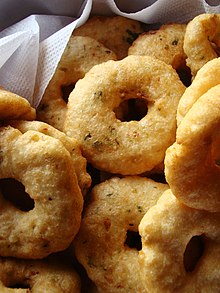 | |
| Alternative names | Garelu, Uddina vade, Medhu vada, Uddi vada, Minapa garelu, Uzhunnu vada, Udid Vada, Ulundu vadai, Urad vada, Ulundu wade, Urdi bara, Batuk |
|---|---|
| Type | Fritter |
| Course | Breakfast |
| Place of origin | India |
| Region or state | South India, Sri Lanka |
| Serving temperature | Warm (with sambar and coconut chutney) or room temperature (with yogurt) |
| Main ingredients | Urad dal (Split Black gram), Rice |
| Similar dishes | Other vadas, mat pe kyaw |
Medu vada (pronounced [meːd̪ʊ vəɽaː]; lit. 'soft vada' in Tamil and Kannada) is a South Indian breakfast snack made from Vigna mungo (black lentil). It is usually made in a doughnut shape, with a crispy exterior and soft interior. A popular food item in South Indian cuisine it is generally eaten as a breakfast or a snack.
Etymology
"Medu" (ಮೆದು) means "soft" in Kannada, thus "medu vada" means "soft vada". The dish is often mentioned simply as "vada" on menus. Other names for the dish include uddina vade Kannada, urad vada, medhu vadai, ulundu vadai (Tamil), garelu(గారెలు) (Telugu), uzhunnu vada (Malayalam), batuk (Nepali), and ulundu vadai (Sinhala).
History
Main article: Vada (food)According to Vir Sanghvi, the origin of medu vada can be traced with "some certainty" to the Maddur town in present-day Karnataka. The dish was made popular outside South India by Udupi restaurateurs of Mumbai.
Preparation
The medu vada is made primarily of black lentils (urad dal) batter. The black lentils are soaked in water for several hours, and then ground to a paste. The paste may be flavoured with other ingredients such as asafoetida, methi seeds (fenugreek), ginger, cumin seeds, black pepper, curry leaves, chillies and coconut pieces. It is then patted into doughnut-shapes and fried in oil until golden brown.
One variation involves baking instead of frying. Other variations of the dish involve use of pulses other than black lentils. For example, am-bada (or aama vadai) is made with chana dal (split chickpea lentil); occasionally, tuar (pigeon pea) and masoor (lentil) are also used.
Serving
The dish is usually served with sambar (lentil and vegetable stew) and coconut chutney. Along with idli, it is often eaten as a breakfast dish. It is also eaten as a lunch starter or a snack.
The medu vada is sometimes also served with yogurt, as a chaat snack (see dahi vada).
In Nepal, on the day of Maghe Sankranti, people make batuk, which is eaten with a variety of boiled tubers such as yam, taro, and sweet potato. Batuk is a traditional festive delicacy of both the Magar and Khas communities of Nepal. Magar people prepare batuk on Maghi, a New Year festival celebrated on the same day of Maghe Sankranti. Magars also eat batuk during weddings, where the groom's family presents batuk to the bride's family alongside pig meat, alcohol, and sel roti. The Newa people of Kathmandu valley have their own version of batuks, known as bara. The Tharu people in the southern part of west Nepal also make black lentil fritters known as bariya, but it is flat or ball-shaped.
Gallery
-
Medu vadas served with coconut chutney
-
 fried Medu vada with chutney
fried Medu vada with chutney
-
 A common South Indian breakfast: idli, medu vada, sambar and coconut chutney
A common South Indian breakfast: idli, medu vada, sambar and coconut chutney
-
Another common breakfast: medu vada, pongal, sambar and coconut chutney
-
In form of dahi vada, with yogurt
See also
- List of deep fried foods
- List of Indian dishes
- List of doughnut varieties
- List of fried dough varieties
References
- ^ Richa Hingle (2015). Vegan Richa's Indian Kitchen: Traditional and Creative Recipes for the Home Cook. Andrews McMeel. p. pt122. ISBN 9781941252109.
- ^ Meher Mirza (15 December 2015). "The Star of South India: Medu Vada in its Many Avatars". NDTV.
- Richa Hingle (2015). Vegan Richa's Indian Kitchen: Traditional and Creative Recipes for the Home Cook. Vegan Heritage Press, LLC. p. 79. ISBN 978-1-941252-10-9.
- Alevur Sriramana Acharya (1971). Barkur Kannada. Deccan College. p. 4.
- ^ Vir Sanghvi (2004). Rude Food: The Collected Food Writings of Vir Sanghvi. Penguin India. pp. 110–111. ISBN 9780143031390.
- Siva Sadasivan (2015). Riding God's Axe. Leadstart. p. 21. ISBN 9789352013609.
- Alamelu Vairavan (2010). Chettinad kitchen. Westland. p. 30. ISBN 9789380283883.
- "Batuk Roti- Black Lentil Patties". 29 January 2014.
- K. T. Achaya (1994). Indian Food: A Historical Companion. Oxford University Press. p. 127. ISBN 978-0-19-563448-8.
- "Recipe: Medu vada". The Times of India. 22 May 2015.
- "The culture, history and recipe of batuk". kathmandupost.com. Retrieved 2021-03-03.
External links
- Medu Vada, South Indian Vada, Daal Vada Archived 2016-04-27 at the Wayback Machine. About.com.
| Dishes |
| ||||||
|---|---|---|---|---|---|---|---|
| Side dishes |
| ||||||
| Snacks | |||||||
| Beverages | |||||||
| Sweets & desserts |
| ||||||
| Condiments | |||||||
| Ingredients | |||||||